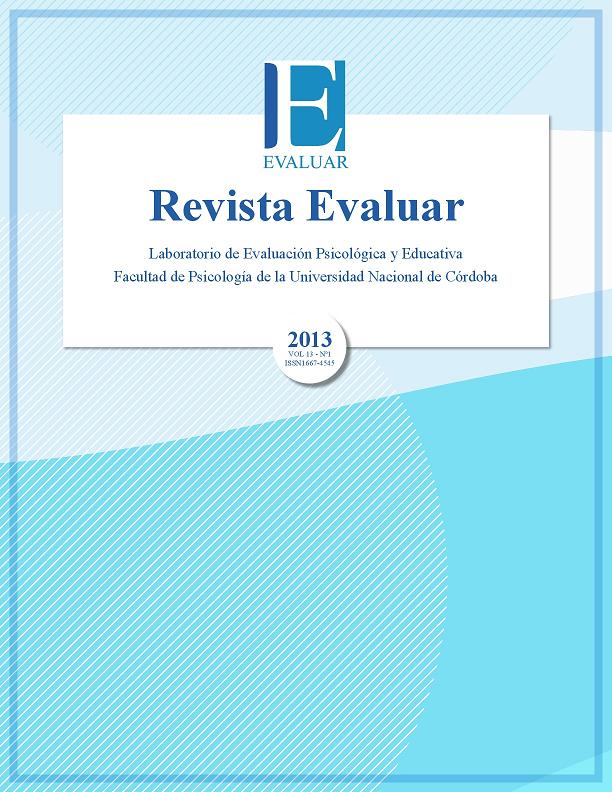Parent’s Rating Scale of Child’s Actual Behavior (PRS): Adaptation for its Use in Buenos Aires
DOI:
https://doi.org/10.35670/1667-4545.v13.n1.6797Abstract
The children psychological evaluation requires a multisource process. This is why having instruments that capture the valuation made by parents about the behavior and attributes of the child is paramount. The aim of this paper is to present the results of the adaptation and validation of the Parent’s Rating Scale of Child’s Actual Behavior (PRS;Harter, 1985) for its use in Buenos Aires (Argentina). The sample of the study was compound by 155 children (age M= 9.53, SD= 1.40) of both genders from Buenos Aires elementary schools and one of their parents. Discriminant item capacity, reliability, construct, content, convergent, and discriminant validity were studied. The results showed that this is a valid and reliable instrument to assessparents' perceptions of the attributes and skills of their school age children in Buenos Aires.
Downloads
References
Acevedo Ponce de León, J. A., & Carrillo Árcega, M. L. (2010). Adaptación, ansiedad y autoestima en niños de 9 a 12 años: una comparación entre escuela tradicional y Montessori. Psicología Iberoamericana, 18, 19-29.
Achenbach, T. M. (1991). Manual for Child Behavior Checklist/ 4-18 and 1991 Profile. Burlington, VT: University of Vermont, Dept. of Psychiatry.
Achenbach, T. M., McConaughy, S. H., & Howell, C. T. (1987). Child/adolescent behavioral and emotional problems: implications of cross-informant correlations for situational specificity. Psychological bulletin, 101, 213-32.
Brendgen, M., Vitaro, F., Turgeon, L., Poulin, F., & Wanner, B. (2004). Is there a dark side of positive illusions? Overestimation of social competence and subsequent adjustment in aggressive and nonaggressive children. Journal of Abnormal Child Psychology, 32, 305-320.
Browne, M. W., & Cudeck, R. (1993). Alternative way of assessing model fit. En K. A. Kollen & J. S. Long (Eds.), Testing Structural Equation Models (pp. 8136-8162). Newbury Park: Sage Publication.
Cardozo, G., & Alderete, A. M. (2009). Adolescentes en riesgo psicosocial y resiliencia. Psicología desde el Caribe, 23, 148-182.
Cole, D. A., Martin, J. M., Powers, B., & Truglio, R. (1996). Modeling causal relations between academic and social competence and depression: A multitrait-multimethod longitudinal study of children. Journal of Abnormal Psychology, 105, 258-270.
Cole, D. A., & White, K. (1993). Structure of peer impressions of children's competence: Validation of the peer nomination of multiple competencies. Psychological Assessment, 5, 449-458.
Cole, D. A., Gondoli, D. M., & Peeke, L. G. (1998). Structure and validity of parent and teacher perceptions of children’s competence: A multitrait-multimethod-multigroup investigation. Psychological Assessment, 10, 241-249. doi: 10.1037//1040-3590.10.3.241
De la Torre, I. M., Cubillas Rodríguez, M. J., Román Pérez, R., & Valdez, E. A. (2009). Ideación suicida en población escolarizada infantil: Factores psicológicos asociados. Salud Mental, 32, 495-502.
Dunn, N., Shields, N., Taylor, N. F., & Dodd, K. J. (2009). Comparing the self-concept of children with cerebral palsy to the perceptions of their parents. Disability and rehabilitation, 31, 387-393. doi: 10.1080/13682820802052125
Forns, M. (1995) Evaluación Psicológica Infantil. Barcelona: Barcanova.
Frick, P. J., Barry, C. T., & Kamphaus, R. W. (2010). Clinical Assessment of Child and Adolescent Personality and Behavior(3ºEd.). New York: Springer. doi: 10.1007/978-1-4419-0641-0
García Cueto, E., Gallo Álvaro, P., & Miranda, R. (1998). Bondad de ajuste en el análisis factorial confirmatorio. Psicothema, 10, 717-723.
Guay, F., Marsh, H. W., & Boivin, M. (2003). Academic self-concept and academic achievement: Developmental perspectives on their causal ordering. Journal of Educational Psychology, 95, 124-136.
Hair, F., Anderson, R. E., Tatham, R. L., & Black, W. C. (1998). Multivariate data analysis with readings. New Jersey: Prentice Hall.
Harter, S.(1985). Manual for de Self-Perception Profile for Children. Denver: University of Denver.
Harter, S. (1999). The construction of the self: a Developmental perspective. New York: The Guilford Press.
Hoffman, K. B., Cole, D. A., Martin, J. M., Tram, J., & Seroczynski, A. D. (2000). Are the discrepancies between self-and others' appraisals of competence predictive or reflective of depressive symptoms in children and adolescents: A longitudinal study, Part II. Journal of Abnormal Psychology, 109, 651-662. doi: 10.1037/0021-843X.109.4.651
Hogan, T. (2004). Pruebas psicológicas: una introducción práctica. México: Manual Moderno.
Hoza, B., Gerdes, A. C., Hinshaw, S. P., Arnold, L. E., Pelham, W. E., Molina, B. S. G., Abikoff, H. B., et al. (2004). Self-perceptions of competence in children with ADHD and comparison children. Journal of Consulting and Clinical Psychology, 72, 382-391. doi: 10.1037/0022-006X.72.3.382
Huebner, E. S. (1991). Correlates of life satisfaction in children. School Psychology Quarterly, 6, 103-111.
Hutcherson, S. T., & Epkins, C. C. (2009). Differentiating parent-and peer-related interpersonal correlates of depressive symptoms and social anxiety in preadolescent girls. Journal of Social and Personal Relationships, 26, 875-897. doi: 10.1177/0265407509345654
Jiménez, T. I., Pérez Murgui, S., & Musitu Ochoa, G. (2007). Comunicación familiar y ánimo depresivo: el papel mediador de los recursos psicosociales del adolescente. Revista Mexicana de Psicología, 24, 259-271.
Jöreskog, K. G., & Sörbom, D. (1989). LISREL7: User’s reference guide. Mooresville: Scientific Software.
Kaufman, J., Birmaher, B., Brent, D., Rao U., & Ryan, N. (1996). Kiddie-Sads-present and lifetime version (K-SADS-PL). University of Pittsburgh School of Medicine-Department of Psychiatry, Pittsburgh.
Kendall, P. C., & Morris, R. J. (1991). Child therapy: Issues and recommendations. Journal of Consulting and Clinical Psychology, 59, 777-784.
Kistner, J. A., David, C. F., Repper, K., & Joiner, T. E. (2006). Bias and accuracy of children’s: Perceptions of peer acceptance: Prospective associations with depressive symptoms. Journal of Abnormal Child Psychology, 34, 349-361.
Molina, M. F., Raimundi, M. J., López, C., Cataldi, S., & Bugallo, L. (2011). Adaptación del Perfil de Autopercepciones para Niños para su Uso en la Ciudad de Buenos Aires. Revista Iberoamericana de Diagnóstico y Evaluación Psicológica (RIDEP), 32, 53-78.
Mikami, A. Y., Calhoun, C. D., & Abikoff, H. B. (2010). Positive illusory bias and response to behavioral treatment among children with attention-deficit/hyperactivity disorder. Journal of Clinical Child and Adolescent Psychology, 39, 373-85. doi: 10.1080/15374411003691735
Nishikawa, S., Sundbom, E., & Hägglöf, B. (2010). Influence of perceived parental rearing on adolescent self-concept and internalizing and externalizing problems in Japan. Journal of Child and Family Studies, 19, 57–66. doi: 10.1007/s10826-009-9281-y
Owens, J. S., & Hoza, B. (2003). The role of inattention and hyperactivity/impulsivity in the positive illusory bias. Journal of Consulting and Clinical Psychology, 71, 680-691. doi: 10.1037/0022-006X.71.4.680
Peterson, C. H., Buser, T. J., & Westburg, N. G. (2010). Effects of familial attachment, social support, involvement, and self-esteem on youth substance use and sexual risk taking. Family Journal: Counseling and Therapy for Couples and Families, 18, 369-376.
Rescorla, L., Ginzburg, S., Achenbach, T. M., Ivanova, M. Y., Almqvist, F., Begovac, I., Bilenberg, N., et al. (2012). Cross-informant agreement between parent-reported and adolescent self-reported problems in 25 societies. Journal of Clinical Child and Adolescent Psychology, 53, 37-41. doi: 10.1080/15374416.2012.717870
Robins, R. W., Donnellan, M. B., Widaman, K. F., & Conger, R. D. (2010). Evaluating the link between self-esteem and temperament in Mexican origin early adolescents. Journal of Adolescence, 33, 403-410.
Rosselló, J., & Berríos Hernández, M. N. (2004). Ideación suicida, depresión, actitudes disfuncionales, eventos de vida estresantes y autoestima en una muestra de adolescentes puertorriqueños/as. Revista Interamericana de Psicología, 38, 295-302.
Seroczynski, D. A., Cole, D. A., & Maxwell, S. E. (1997). Cumulative and compensatory effects of competence and in competence on depressive symptoms in children. Journal of Abnormal Psychology, 106, 586-97.
Schmidt, V., Barreyro, J. P., & Maglio, A. L. (2009). Escala de evaluación del funcionamiento familiar FACES III: ¿Modelo de dos o tres factores? Escritos de Psicología, 3, 30-36.
Schmidt, V., Messoulam, N., & Molina, M. F. (2008). Autoconcepto académico en adolescentes de escuelas medias: Presentación de un instrumento para su evaluación. Revista Iberoamericana de Diagnóstico y Evaluación Psicológica, 25, 81-106.
Shin, H. (2010). Does depression moderate or mediate the relations between deficits in children competence and aggression?: A short-term longitudinal study of Korean. School Psychology International, 31, 331-352. doi: 10.1177/0143034310377139
Swann, W. B. Jr., Chang-Schneider, C., & McClarty, K. L. (2007). Do people’s self-views matter? American Psychologist, 62, 84-94.
Swanson, J. M. (1992). School-based assessments and interventions for ADD students. Irvine, CA: KC Publishing.
Tompkins, T. L., & Wyatt, G. E. (2008). Child psychosocial adjustment and parenting in families affected by maternal HIV/AIDS. Journal of Child and Family Studies, 17, 823–838. doi: 10.1007/s10826-008-9192-3
Tornimbeni, S., Pérez, E., & Olaz, F. (2008). Intruducción a la Psicometría. Buenos Aires: Paidós.
Van Den Bergh, B. H., & Marcoen, A. (1999). Harter’s self-perception profile for children: Factor structure, reliability, and convergent validity in a Dutch-speaking Belgian sample of fourth, fifth, and sixth grades. Psychologica Belgica, 39, 29-47.
White, B. A., & Kistner, J. A. (2011). Biased self-perceptions, peer rejection, and aggression in children. Journal of Abnormal Child Psychology, 39, 645-656. doi: 10.1007/s10802-011-9506-6
Downloads
Published
How to Cite
Issue
Section
License
Copyright (c) 2013 María Fernanda Molina, Alejandra Calero, María Julia Raimundi

This work is licensed under a Creative Commons Attribution 4.0 International License.
Revista Evaluar aplica la Licencia Internacional de Atribuciones Comunes Creativas (Creative Commons Attribution License, CCAL). Bajo esta licencia, los autores retienen la propiedad de copyright de los artículos pero permiten que, sin que medie permiso de autor o editor, cualquier persona descargue y distribuya los artículos publicados en Evaluar. La única condición es que siempre y en todos los casos se cite a los autores y a la fuente original de publicación (i.e. Evaluar). El envío de artículos a Evaluar y la lectura de los mismos es totalmente gratuito.




_(3).jpg)



.jpg)



